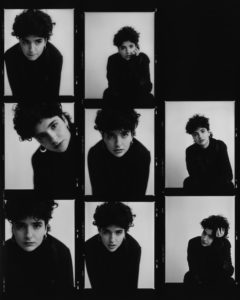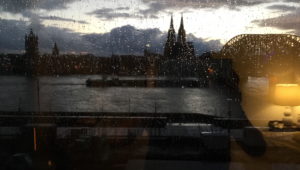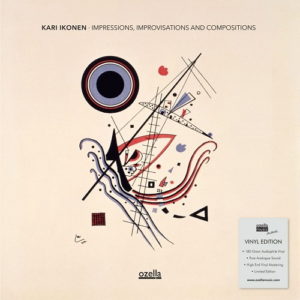A talk with Rasha Nahas about her album Desert – which should be a striking candidate for Manafonistas‘ best albums of 2021 lists. Rasha Nahas was born into a Palestinian family in Haifa where she grew up and lived before she moved to Berlin in 2017. In Germany she has been working with various musical and theatre productions and has just released her debut debut album Desert on her label Rmad Records.
One of the many things I find remarkable about your album is that these songs sound like you had been living with them for a while. I can’t exactly tell if I get that impression from the arrangements or from that fine flow in the lyrics. Some of the lyrics have such a wild, or complex, imagery that seems to be a mix of very personal thoughts and feelings and also some sentiments about society and the places you lived in. Lots of songs have a striking energy that sounds elaborate and emotionally lived-through at the same time.They sound like songs that have had some history before they’ve been put on tape.
The songs went through different arrangements. Yes, I lived with them – played them acoustically, only me with classical guitar, then I did them with more electronic elements, and then with different musicians. Little by little I started gathering the band. Me and the violinist [Shaden Nahra] have played together for seven or eight years. There was a very strong connection between me and the musicians, and we definitely explored and lived the songs a lot. It’s not a matter of time, though, rather a matter of commitment and a sense of being involved artistically. I actually wrote a lot of songs for this album, I just didn’t release them, apart from an EP in 2016.
You developed the music partly in your hometown, Haifa, and then you toured with it before you recorded it here in Berlin?
Yes, the music was written during my last few weeks in Haifa and during my first few weeks in Germany. It was really written through my transition. The title track, “Desert”, for example I wrote in my apartment in Haifa the month before I left. “The Clown” and “Ashes” were written in my first apartment here in Berlin. It was really like documenting my travel, documenting that period of my life, asking myself where I want to be – and doing it.
And that was three or four years ago?
Yes, I moved to Germany in the summer of 2017. I simply had a lot of friends here in Berlin. In 2017, we played Glastonbury Festival in England and a few other gigs, and it just made sense that I stayed here. Then I started performing here and applied for an artist visa.
The whole album really sounds like it could have been live in the studio, although I’m guessing there was a lot of work involved with how the the violin, the cello and the instruments in general blend together.
After I wrote the songs, we arranged the basics with the band, like verse, chorus, the lengths of sections and such. I worked mainly with the bass and the drums to really gain this solid, heavy feeling. The songs are intense there’s something very … like stepping in mud, you know? To me that feels like heavy steps. That was the the main work, to realise this solid rhythm section to build on.
We did work a lot with the cello and the violin lines, some of which I had in my mind – for example “Ashes”, these lines [sings] I must have had forever. I was always singing that when we were rehearsing. Then we were in the studio, and we’d never discussed it before, but I just went like, “try this line“. And it worked. A few songs were done in one take, “The Fall” for example, all of us together, including the vocals. We didn’t dub anything, just mixed it.
What was the co-producer’s role on this project? Where did he come from?
As for the co-producer, I basically needed someone on the technical side. As a band, we had a vision – we had a sound, but with me being lead singer and guitarist, I needed someone to execute this sound in a technical way. Plus, Jonathan is a great musician; he was a classical pianist. I trust him when it comes to giving me feedback, as a person from outside the band. Jonathan also mixed the album. I needed the same engineer to mix it, because the band really had a very specific sound, which I don’t think I could have executed without him.
In “Cat Lady“ I like this this raw atmosphere, with the guitar sounding almost like it was improvised, very much like played on the spot.
For “Cat Lady” we recorded bass, drums and guitar, then added violin and cello. And then I didn’t like the guitar part. So I just played one take of guitar on it. That was basically improvised. It was two chords, this whole song, but it has many variations. We play a lot with the colours. So with the guitar part I am basically reacting to what’s happening around me.
Indeed, you present all sorts of different colours on this album. At first it can be a bit overwhelming – for the listener, having all these different vantage points on your creative personality. All these elements are very fascinating to roam and experience. Every time I put on the CD, it feels like listening to a new album again. Let’s take the Leonard Cohen song: At first one might think, “why does a Leonard Cohen song end up on this album?”, but having listened to the album many times I in a way forgot it once was a Cohen song … until that fabulous chorus comes in and reminds me. Your recording of that song comes across as a very personal take, even though it’s not one that you wrote. Usually I’m a bit hesitant about people covering famous songs – and Cohen’s have been covered and recorded a lot. Singers often perform it in such a way that you can hear they like the song, but their take is not in any way unique. Here, it sounds like it’s your song, like there’s a deep personal connection. That’s why it fits splendidly into the overall concept of your album.
He’s a big inspiration. He’s one of the greatest songwriters that ever lived, at least in English music. His work definitely shaped a certain part of how I write in English and express specific things. I love this song very much. I played it acoustically on classical guitar a lot. During one rehearsal I plugged in my guitar, we were still in the beginning, like half tuning, half jamming … I started playing it, and then the bass gave the first note, then the drums did a bit of cymbals, then we went to the six eighths, and then the cello came in… So I just felt like recording it, because I think it’s a song that speaks about identity, about not recognizing yourself, about transition, about love. It’s also a dialogue with the father that can be also God, so it’s a somewhat religious song – this whole thing about covering the face… It’s very metaphorical but also very specific. It fit the album really well.
It does fit on the very personal side of these songs on the album. There are lots of very personal moments to it, but they’re never as bare as if you’re talking about something private. “Ashes” is a good example. It sounds like a very personal story, and this is where “Lover Lover Lover” fits in. “Ashes”, the longest and one of the most dramatic songs on the album, starts like it’s a quiet one and then it becomes more dramatic. And in the end it calms down again. I had this feeling that it’s probably a love song, but the metaphors you chose are anything but ordinary. They could easily relate to something else than merely a personal situation from a relationship.
“Ashes” is a love song, yes. It started from cigarette ashes. You find an ashtray with a lot of ashes of cigarettes. But it’s also a metaphor for burning, like when you get close to fire and then lose your balance – like a musician on stage is completely surrendering to the music, and burning, and after the concert thinking what is left. That sounds a bit tragic, but it’s also beautiful. And it’s about love, about relationships and balance, learning about the line between you and the other person. “And my ashes remain in the room as you leave” – it’s a beautiful metaphor. It’s one of my favorite songs on the album and one of my dearest things I wrote so far. I’m sharing a lot there.
I love personal music. Take Jeff Buckley, for example, or Joni Mitchell. If you go back in time, there was no ego in love songs – or maybe it was ego in a different way. I feel today love songs are so much about ego, and there’s a lot of thinking about how you’re perceived.
It’s great how these songs are more like open vessels for my – or other listeners’ – associations. And then there are others which are more eccentric. There’s lots of these associative elements which I find really fascinating to be drawn into. Did you work a lot on the lyrics, before you decided this is the final text? How much time do you spend on developing a song?
It’s different with every song. For “The Clown” it took 15 or 20 minutes to write the text. The arrangement took a bit more time, finding out how we’ll do it, rehearsing all the stops and the riffs. “Ashes” I wrote in the morning, then I went on my bike to get something in the city. I remember listening to the recording I had made on my phone, thinking about what I was going to change. Then I came back home, changed it – and that was it.
For me, with text I usually feel like it may not be perfect, and even though I could make everything sound a bit better or fix everything so that it will be more accurate, but I think that I prefer to just keep it as it is, because it’s what it is. I never felt that reservation of things not being good enough to let them out. It’s like taking a photograph and showing it to a friend. It’s a beautiful, very fluid process, and there’s no right and wrong. There is a lot of space to create and to invent.
You started playing music when you were very young and played classical guitar when you were about ten? Why didn’t you become a classical guitarist, or rather, where did you start taking a different turn? When did you decide to go down this path as a songwriter between cultures and countries?
I love classical music. But to play classical guitar is like flying an airplane – if you really want to do it in a way to pursue a career. In a way I find it classical music very impressive and very “royal” – to see people playing such sophisticated music and investing their life into manifesting it in a great way. I guess the music I make is more direct and accessible than classical music. My classical guitar studies were enriching for my experience as a musician, but I had something to say. I wanted to write songs. I wanted to speak to people. I wanted to share verbally. I just feel that I’m a songwriter.
When I was very young, I really grew up on John Lennon. He’s great. My Dad had a collection of Lennon CDs, and I just listened to them like every time I was in the car – every time we were driving somewhere, to visit my grandparents in the village or wherever. So it was like John lLennon from like my early my earliest memory of music. And later on we got Queen and Freddie Mercury, just like such great rock bands.
Lennon and Mercury – that makes sense to me, listening to your album.
About this album cover: What’s the story behind the image? Was it your idea, or where did this artwork come from?
It was a deep dialogue with the graphic designer [Haitham Haddad]. He is an amazing artist. He was a good friend of my sister’s and I’ve known him since high school. When we recorded the album I didn’t know the order of the songs, didn’t know how it’s all gonna be put together. The pieces felt so different from each other. Admittedly that was my plan: I didn’t want to create one genre. I don’t believe in genres anyway, I just want to do art and express feelings, express thoughts, express myself. And I realized it’s a collage. It moves and it takes you with it. Every song is a journey, but the whole thing is also a journey. It’s very personal, but also very theatrical – so the double exposure with the different layers basically represents the album like different personalities. The theatricality is in the distortions and the burned colour. There’s also something very clear in the face, but there’s this moving and shifting thing around it, it’s fluid. The graphic designer did a brilliant job.
How have you changed since the album has been finished? It’s been a while since you recorded it, and judging from all the projects you worked on since then, you seem to be in a very different place now, artistically at least.
Yes, it took time for me to understand what this album means. I started “Desert” in 2018 and I did a crowdfunding campaign. Then after the recording I had an injury in both my hands which stopped me from making music for almost a year. I had inflammation in my hands, and I couldn’t play guitar or carry my groceries, make food or type emails. I was not in a good place. I’m doing okay now, but I needed time to heal, time to to be with myself, prioritize things a bit.
I learned to know my limits. I started touring a lot, and it was the most important thing for me for some time. My music was more important than myself. It was a very romantic relationship to my art. It still is important, but it’s different; it’s healthier, because being ill for many months and not being able to play music taught me a lot about my relationship with music and my relationship with myself. I was forced to prioritize myself, my well-being, my health before everything else. That was the most precious lesson I learned in my life.
My relationship with music can still be the ashes that remain in the room, you know, but it’s a bit more balanced. I found a very beautiful relationship with music that is not as tragic. I just learned to do it in a way that is good and healthy.That’s the main thing that changed.
Making the album felt very intuitive. I’ve been through a lot with it, and it was very important for me to release it, before I release anything else. And it took me time to put it in a frame and say, “okay, this is what it is”, and so it’s such a perfect timing for it to be out now. It’s like opening a new chapter.
–
The conversation between Rasha Nahas and IJ.Biermann, recorded in Berlin in March 2021, has been edited and condensed for clarity.




